Not many things we do in education decrease kids achievement and some of these actually make sense. The presence of one disruptive kid in a class negates the performance of most kids, so when you take those kinds of negative ones you’d expect to be negative out, about 95 to 97% of things that we do to kids to enhance their achievement work. — Hattie
When you combine Hattie’s research on student achievement with the foundational ideas on learning from educational thought leaders like Dewey, Bruner, Piaget and Papert one can argue the human being is the most amazing learning entity in the face of the planet. I like to summarize these ideas by suggesting that just as long we aren’t physically or psychologically harming our learners almost anything we do as an instructional practice will help our students achieve.
But as Hattie warns just because we can show some type of improvement in achievement that doesn’t mean that anything goes and that we should continue to do what we have always done in the classroom. On the contrary, Hattie points to his research that shows we need to focus on those things that will move student achieve beyond the average effect size of .4. We need to do those things that will help our students learn the most.

We need to focus on the things like formative feedback, visible and mastery learning and much more that will do the most to improve student achievement and not focus on the politically expedient things like class sizes, rigor, and homework and so many other things which have a smaller than average impact on achievement. The following videos and images below provide an effective summary of what we should be focusing on to improve student achievement.
Hattie spends a considerable time talking about Outward Bound activities because they make learning visible, provide an authentic context for learning, and also give the learner immediate feedback on the learning process. Authentic learning opportunities feed Hattie’s notion of visible learning because they provide a wonderful opportunity for teachers to evaluate their own teaching and enable the teachers to see learning through the eyes of their students and help their students become their own teachers and learn how to learn (Hattie, 2009, 2011). Hattie also argues that teacher must develop the following mind frames that underpin their every action and decision:
- My fundamental task is to evaluate the effect of my teaching on students’ learning and achievement.
- The success and failure of my students’ learning is about what I do or don’t do. I am a change agent.
- I want to talk more about learning than teaching.
- Assessment is about my impact.
- I teach through dialogue not monologue.
- I enjoy the challenge and never retreat to “doing my best”.
- It’s my role to develop positive relationships in class and staffrooms.
- I inform all about the language of learning.
John Hattie: Visible Learning Pt 1. Disasters and Below Average Methods.
John Hattie, Visible Learning. Pt 2. Effective Methods
Source: Hattie Ranking: Teaching Effects
Additional student achievement ideas to consider:
Full Hattie Ranking – https://visible-learning.org/hattie-ranking-influences-effect-sizes-learning-achievement/
Hattie’s Visible Learning site – https://visible-learning.org/
The key to improving student achievement – https://www.harapnuik.org/?p=6434
References
Bell, M. (2011, November 28) John Hattie: Visible learning Pt 1 disasters and Below average methods. [Video File]. Retrieved from http://youtu.be/sng4p3Vsu7Y
Bell, M. (2011, December 1) John Hattie: Visible learning Pt 2 effective methods. [Video File]. Retrieved from https://youtu.be/3pD1DFTNQf4
Bruner, J. S. (1960). The process of education. Cambridge, MA: Harvard University Press.
Dewey, J. (1916). Democracy and education: An introduction to philosophy of education. New York, NY: Macmillan.
Hattie, J. (2008). Visible learning: A synthesis of over 800 meta-analyses relating to achievement. Routledge.
Papert, S. (1993). The children’s machine: Rethinking school in the age of the computer. New York, NY: Basic books.
Piaget, J. (1964). Development and learning. In R.E. Ripple & V.N. Rockcastle (Eds.), Piaget Rediscovered: A Report on the Conference of Cognitive Studies and Curriculum Development (pp. 7–20). Ithaca, NY: Cornell University.



































This is a fantastic article! In the list of influences, does ‘acceleration’ refer to learning pace? I’ll be watching John Hattie’s Visible learning video. Being new to adult education, you are both very inspiring people. Can’t wait for our first discussion!
While the notion of “acceleration” referred to here does have some aspects of learning pace, it has more to do with moving a learner along faster or advancing them into more challenging learning opportunities than it does simply with the pace of speed of their learning. More challenges provide more opportunities for learner’s growth. Think about moving a younger athlete up to play with other athletes. This would be a good example of acceleration.
Great timing. We are often so busy we forget to focus on what works in teaching. Thanks for the reminder.
Glad the reminder is timely. I know I continually need to remind myself of this. It is easy to focus on the hot topic or the whirlwind.